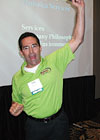
Louis
Hobaica of Hobaica Services energizes the audience at the Refrigeration
Contracting Roundtable with the assist of Aaron York of Aaron York’s Quality
A/C.
The first Refrigeration Contracting Roundtable drew a couple of dozen attendees and came at the conclusion of a week that began with the new Green Contracting Summit and continued with the 7th Annual Commercial Contracting Roundtable and the 3rd Annual Service Managers Forum.
The last day and a half of sessions was geared specifically to refrigeration contractors and service technicians.
For example, Peter Powell, refrigeration editor ofThe NEWS, noted that while air conditioning contractors have to deal with primarily one HFC refrigerant - R-410A - refrigeration contractors could potentially have to work with 18 HFCs. Some of those HFCs work only with POE oils, some with MOs, and some allow a mixture of the two types of oils. Some are for new installations only, while others are for the retrofit of units designed to run on HCFC-22. Then those retrofit refrigerants may not work in as wide a range of applications as R-22. There was also discussion of regulatory issues which at the time of the conference in early October did not seem pressing, but was a situation that could change depending on pressure from environmentalists and Europe.
Nick Strickland, who leads the Isceon® refrigerants team at DuPont, talked about the drop off in production of virgin R-22 that includes a yearly step down.
He said an “R-22 shortfall is likely” so company’s should “use R-22 as a corporate asset.” He went into detail on several of the retrofit HFCs that could work with systems originally designed for R-22. In such cases, he said, attention has to be paid to pressure enthalpy and MO compatibility. In all cases, he said, “Be prepared with a refrigerant management plan.”
Louis Hobaica, president of Hobaica Services, told attendees that service agreements can work just as well on the refrigeration side as they do in the air conditioning sector.
“Service agreements create cash flow and create loyalty. They are in the best interest of the customer and the best interest of the company.” He did say that such maintenance agreements only work “if the employees buy into the plan.” Such paperwork needs to be kept simple, he said. “It’s not rocket science. Make it tech friendly.”
Danny Halel, applications engineer manager for Hussmann, reviewed the right equipment for the job. He also showed the complexity of the refrigeration technician’s job by noting supermarket options related to parallel racks that are used in direct expansion, secondary systems using 35 percent glycol, and in secondary using CO2. Then there are distributed systems using DX, secondary glycol, and secondary CO2. And there are CO2/cascade systems of which he said, “few exist today (less than 25 in the United States); however, they will be a bigger player in the coming years.”
Don Langston, president of Aire Rite Air Conditioning and Refrigeration, focused on the controls technology. For example, he said there are now “self powered network components with no batteries and wires.” They work, he said, with “energy harvesting” in which a slight change in motion, pressure, lighting, temperature, and vibration create energy to keep the unit running.
Finally, Aaron York of Aaron York’s Quality Air-Conditioning spoke of emerging applications in the medical field as where refrigeration, freezing or even cryogenics are used. He noted such areas as incubators, centrifuges, shakers, environmental chambers, and ultra-low temperature rooms. “While this work is not for the faint of heart, it is highly rewarding,” he said. “While dollars are always important to every user, the quality of service performance with accuracy and no callbacks is far more important.”
Publication date: 12/06/2010

Report Abusive Comment